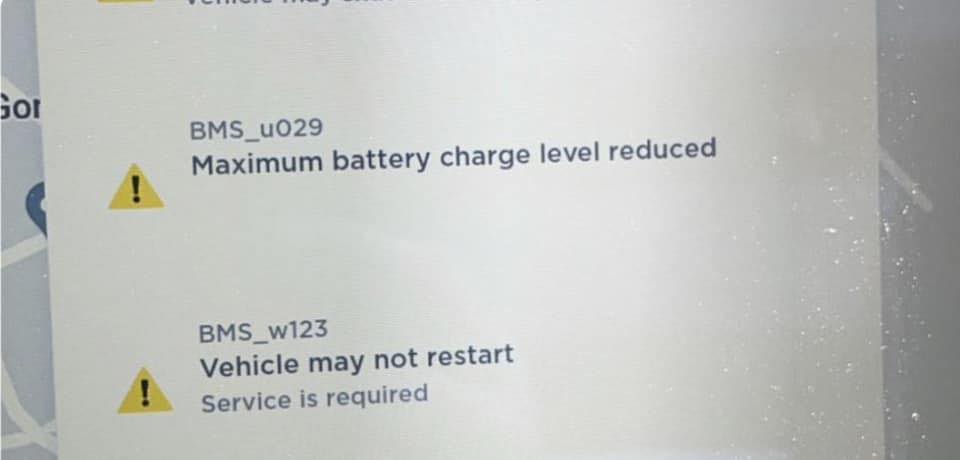
Understanding the Risks and Importance of Resetting BMS_u029 and not repairing battery pack/blocks/cells.
We have been working on an issue related to BMS_u029 at EV CLINIC since March 2022 (https://evclinic.eu/2022/10/03/tesla-battery-repair-bms_u029/) , and we believe it’s crucial to share the findings.

The attached graphic displays four modules, two of which are from separate battery packs that came to us with a BMS_u029/Weak Short cell defect, and the other two from separate packs with a BMS_u018/Capacity Imbalance error.
These illustrations reveal something remarkable. Each red dot represents a cell that is experiencing self-discharge, occurring at a rapid rate of up to 20 mV per hour or more. When isolated from the rest of the brick, these cells discharge completely within 1 day, reaching 0 volts. (Typically, a healthy cell would discharge at a rate of <0.5 mV per day, which is a thousand times slower.)
Interestingly, the red dots are only present on the left side in the BMS_u029 column, while there are none on the right side in the BMS_u018 column. This is not a coincidence. It’s worth noting that these modules are not unique, as we have observed the exact same behavior across numerous modules.
What’s intriguing is that both the BMS_u029 and BMS_u018 modules exhibit noticeable capacity imbalances, with differences of up to 15 Ah or more in the case of the BMS_u018 modules, but it is usualy 6-10Ah. However, they manifest in two distinct failure modes.
In the case of the BMS_u018 modules, the cells themselves function fine with minimal self-discharge and can continue to operate, albeit with reduced capacity. These cells can even be repurposed or recycled for secondary use, just not in their current configuration as Model S battery modules.
On the other hand, each red dot in the BMS_u029 modules represents a potential runaway thermal event .
The top left module, apart from resembling chickenpox, is particularly alarming. Having this module in your pack would be highly undesirable, and resetting BMS errors on it is strongly not recommended if you didnt find and repair defect brick / cell.
Even the lower left module has one cell that poses a risk. If that cell shorts, it could trigger a potential runaway thermal event.
Furthermore, the BMS can identify even a single cell with the potential “weak short” and flag it as such. It latches the error to prevent inadvertent resetting or overlooking during unrelated firmware updates, system reboots, etc.
Additionally, the BMS can distinguish cells with potential weak shorts from worn and tired cells with capacity imbalances. It correctly recognizes the latter as being worn and tired, but not posing a significant threat. In fact, if the charge balance improves between cycles, the BMS will clear the BMS_u018 error and restore the battery’s normal operation, albeit at a diminished capacity.
In summary, Tesla’s BMS features are known to be exceptionally stringent when it comes to safety in battery systems. Understanding the problem referred to as “weak short” or “short to brick” took time, as it was a novel issue encountered initially by ourteam. For the BMS_u029 error, the rule is activated only when the battery remains idle for an extended period (approximately 8 hours or more) and exhibits a linear voltage drop in any of the 96S bricks. Activation triggers the w117 and u029 processes. This check is performed exclusively when the vehicle is not in use, and one out of the 76x 18650 cells in parallel becomes a consumer. The resulting damage is estimated to be in the range of €2-4. Initially, it was unclear which processor and memory stored the error flag/log and where the error transmission originated from.
It is important to say after all work and research, there is no easy way to address those issues without proper training and thats why we offere it to our partners and franchises.
https://evclinic.eu/evc-knowhow-academy/tesla/hv-battery/s-x-battery-master-training-operation-manual-2023612001/
Therefore, a couple of key takeaways emerge:
- Tesla is not bricking these packs inoperable with OTA software updates(it is not programmed defect like found in Mercedes vehicles) or by surreptitiously modifying thresholds during MCU upgrades. The BMS_u029 weak short conditions in the latest BMS firmware are genuine and implemented for your safety. We have observed this behavior in all the BMS_u029 packs we have received. We have numerous decommissioned modules with identical results. The BMS_u029 modules have cells experiencing self-discharge, while the BMS_u018 cells are worn and tired.
During the decommissioning process, we remove the collector plates, as shown in the attached photos, to isolate each cell. We then dismantle the module as necessary to repurpose any good cells for secondary use.
- It is extremely important not to reset these BMS_u029 errors without addressing the underlying issues with cells.




